Understanding Modern Crematory Lifts: Safety, Efficiency, and Options
A crematory lift is specialized equipment designed to safely and efficiently transfer deceased individuals into cremation chambers. These lifts typically handle weights between 500-1000 pounds and raise to heights of 12-80 inches, eliminating manual lifting and reducing injury risk for funeral home staff.
Quick Guide to Crematory Lifts:
- Purpose: Safely transfer remains into cremation chambers
- Types: Manual hydraulic, battery-powered, electric actuator
- Weight Capacity: 500-1000 lbs standard
- Materials: Aluminum (lightweight), stainless steel, welded steel
- Key Features: Multi-directional rollers, scissor mechanism, roller locks
- Price Range: $5,000-$11,000
The cremation industry has seen significant growth in recent years, with larger cases becoming more common and staff safety concerns rising to the forefront. As one funeral director noted, "After only a few uses of our crematory lift, I'm completely dependent on it. Everyone should be using one."
Modern crematory lifts have transformed how funeral homes handle remains, replacing dangerous manual lifting with smooth, controlled, often single-operator systems. These specialized devices not only protect staff from back injuries but also show respect for the deceased through dignified handling.
I'm Mortuary Cooler, a national-level supplier of mortuary equipment with extensive experience providing custom crematory lift solutions to funeral homes across the United States. Having helped hundreds of funeral directors select the right equipment for their specific needs, I understand the critical balance between functionality, durability, and value.
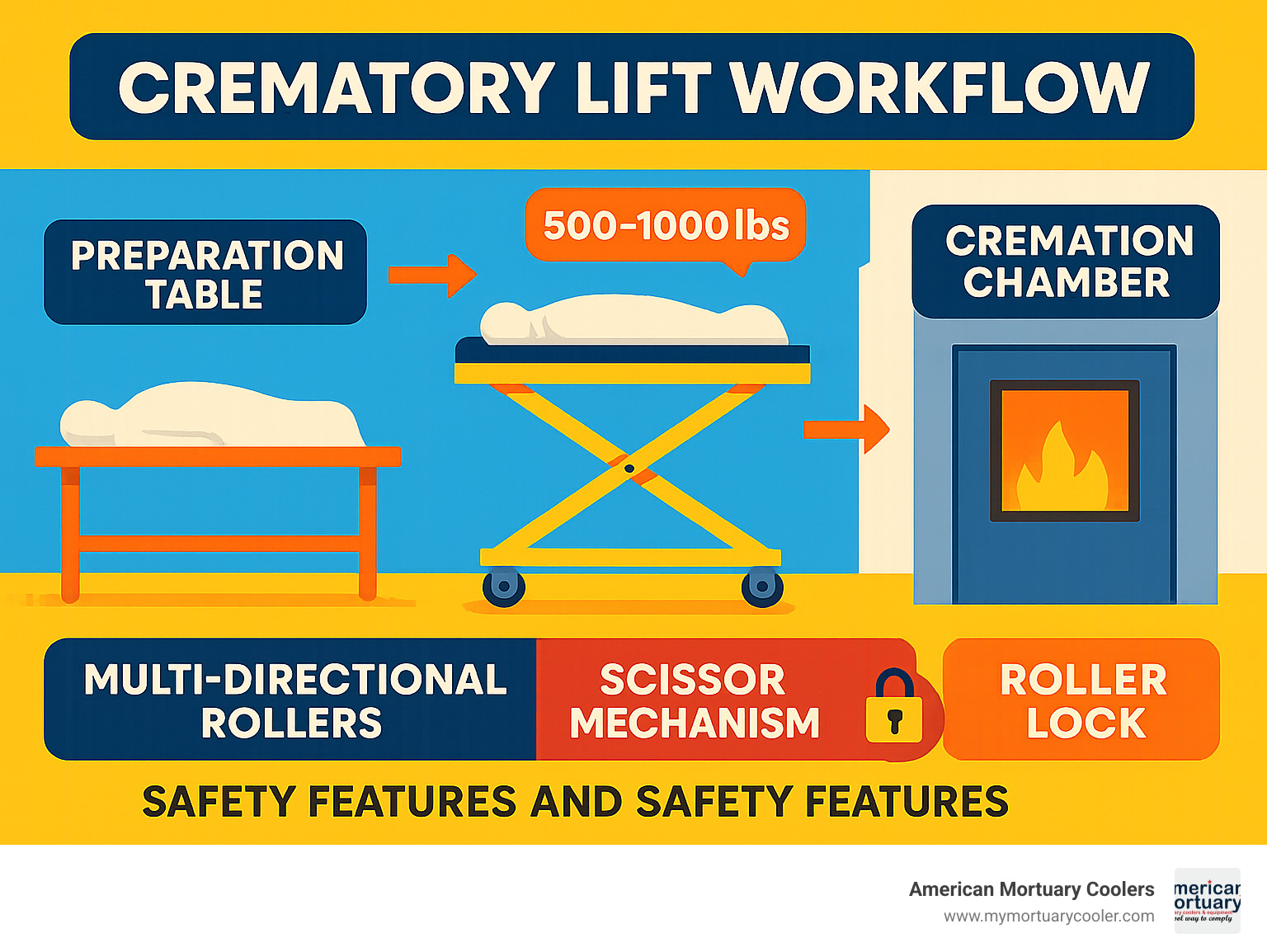
Similar topics to *Crematory lift *:
Crematory Lift Types & Key Specifications
When shopping for a crematory lift, you'll quickly find there's not just one type that fits all funeral homes. Having helped countless funeral directors across Tennessee and nationwide, we at American Mortuary Coolers understand that finding the right lift makes all the difference in your daily operations.
Manual Hydraulic Crematory Lifts
There's something reassuringly simple about manual hydraulic crematory lifts. They operate using good old-fashioned foot-pump or hand-pump mechanisms, making them the Toyota Corolla of the mortuary world—reliable, affordable, and they get the job done without fancy bells and whistles.
Starting around $5,500, these lifts are perfect for smaller funeral homes watching their budget. They typically handle up to 1000 pounds and can raise from a low height of 12-13 inches up to 69-74 inches. The double scissor design ensures stability even with heavier cases.
One funeral director from Chicago told us with a smile, "Our manual hydraulic lift isn't flashy, but it's like that reliable employee who never calls in sick. It just works, day in and day out."
The trade-off? You'll need to put in a bit more elbow (or rather, foot) grease to operate it, and you won't find any electrical components or batteries to maintain.
Battery-Powered Crematory Lifts
If manual lifts are the reliable Corollas, battery-powered crematory lifts are the Tesla Model 3s—smooth, powerful, and decidedly modern. These have become our most popular option, striking the perfect balance between convenience and capability.
Running on a 12V DC hydraulic pump system with a rechargeable battery, these lifts offer push-button simplicity. They typically handle 800-1000+ pounds and can reach impressive heights of 78-80+ inches while starting from a low profile of 19-20.5 inches.
"The battery-powered lift has transformed our workflow," shared one Dallas crematory operator. "My staff actually argued over who gets to use it first—it's that much of a game-changer."
A single charge typically lasts several days of normal operation, and recharging is as simple as plugging into a standard outlet. No pumping, no straining, just smooth lifting at the touch of a button.
Electric Actuator Crematory Lifts
For facilities with fixed cremation equipment, electric actuator crematory lifts offer consistent, reliable power. These models need a constant connection to an electrical outlet, but in return, you'll never worry about a dead battery in the middle of a busy day.
With weight capacities up to 1000 pounds and precise height control, these lifts often feature remote operation capabilities that allow staff to maintain a safe distance during the transfer process.
Trolleys and Winch Systems
Beyond traditional scissor lifts, the crematory lift family includes specialized options for unique situations:
Casket trolleys focus on horizontal transport rather than vertical lifting, with fixed heights and prices ranging from $3,000-$4,500. Winch systems, whether vehicle-mounted or wall-mounted, use cables to position cremation containers and typically handle 600-1000 pounds. For facilities that need to move remains between vehicles and buildings, tug-along systems with wireless remote controls offer specialized solutions.
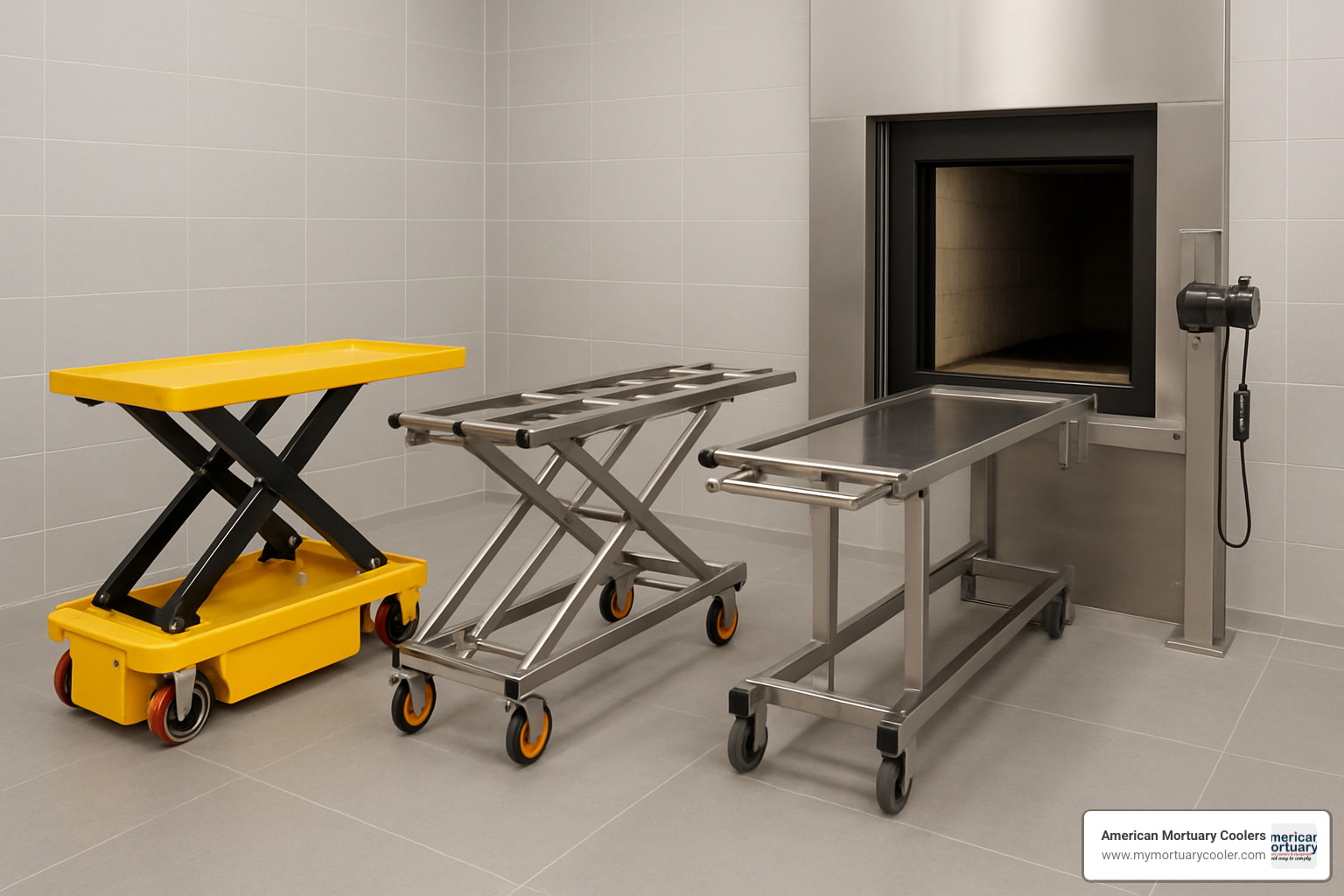
| Lift Type | Weight Capacity | Lift Range | Power Source | Approx. Price Range | Best For |
|---|---|---|---|---|---|
| Manual Hydraulic | 1000 lbs | 12-74" | Human power | $5,500-$6,600 | Budget-conscious facilities |
| Battery-Powered | 800-1000+ lbs | 19-80+" | 12V battery | $6,800-$8,500 | Most crematories |
| Electric Actuator | 1000 lbs | 20-78" | Electrical outlet | $7,500-$9,000 | Fixed installations |
| Casket Trolley | 500-800 lbs | Fixed height | N/A | $3,000-$4,500 | Horizontal transport |
| Winch System | 600-1000 lbs | Varies | 12V or 110V | $2,000-$4,000 | Vehicle loading |
Manual vs Battery-Powered Crematory lift Options
The manual vs. battery debate often comes down to your facility's specific needs. Manual hydraulic lifts offer a lower initial investment with no battery maintenance concerns. They're reliable in all weather and power outage situations but require more physical effort with that foot-pump operation. They also lift more slowly and might need two staff members for heavier cases.
Battery-powered crematory lifts, on the other hand, offer push-button convenience and faster, smoother lifting that typically enables single-operator use even for substantial cases. Yes, they cost more upfront and require occasional battery maintenance, but the efficiency gains are substantial.
As one Atlanta funeral director confessed to us with a laugh: "We started with a manual lift because I'm, well, frugal. But after trying a battery-powered model during a demonstration, I wrote that check so fast my pen nearly caught fire. The difference was night and day."
Aluminum vs Steel Crematory lift Frames
The material battle between aluminum and steel is about more than just weight—it affects everything from maneuverability to longevity.
Marine-grade aluminum frames are about 50% lighter than steel models, typically weighing around 390-395 pounds. This lighter weight makes a world of difference when maneuvering through tight spaces or across carpeted areas. They also resist corrosion beautifully in humid crematory environments but do come with a higher price tag.
Welded steel frames offer maximum durability for high-volume operations at a lower initial cost. The trade-off is weight—these beasts typically tip the scales at 700-800 pounds—and they require more maintenance to prevent rust in damp conditions.
For those wanting the best of both worlds, stainless steel frames offer superior corrosion resistance and easy cleaning, though at the highest initial cost.
A Los Angeles crematory manager shared with us: "We chose the aluminum lift for our 1920s building with its narrow doorways. Three years later, it still looks brand new despite daily use, and my staff doesn't grumble about moving it around anymore."
Want to learn more about side-loading options? Check out our detailed guide on understanding cremation lift tables and scissor lifts.
Safety, Efficiency, and Ergonomic Benefits
Adding a crematory lift to your funeral home does far more than just raise and lower remains. At American Mortuary Coolers, we've witnessed how these specialized tools transform operations for funeral homes across Tennessee and nationwide.
Injury Prevention and Staff Safety
Let's face it - the funeral industry involves physically demanding work. Back injuries from lifting are unfortunately common, but a crematory lift directly addresses these concerns by eliminating manual lifting altogether.
One funeral director in Pittsburgh told us with a smile, "Before our crematory lift, it felt like we had a rotating schedule of who was out with a back injury. Three years later, and we haven't had a single lifting-related injury!"
Beyond preventing painful injuries, these lifts ensure OSHA compliance and significantly reduce workers' compensation claims. The math is simple - fewer injuries mean lower insurance premiums and fewer days lost to recovery time.
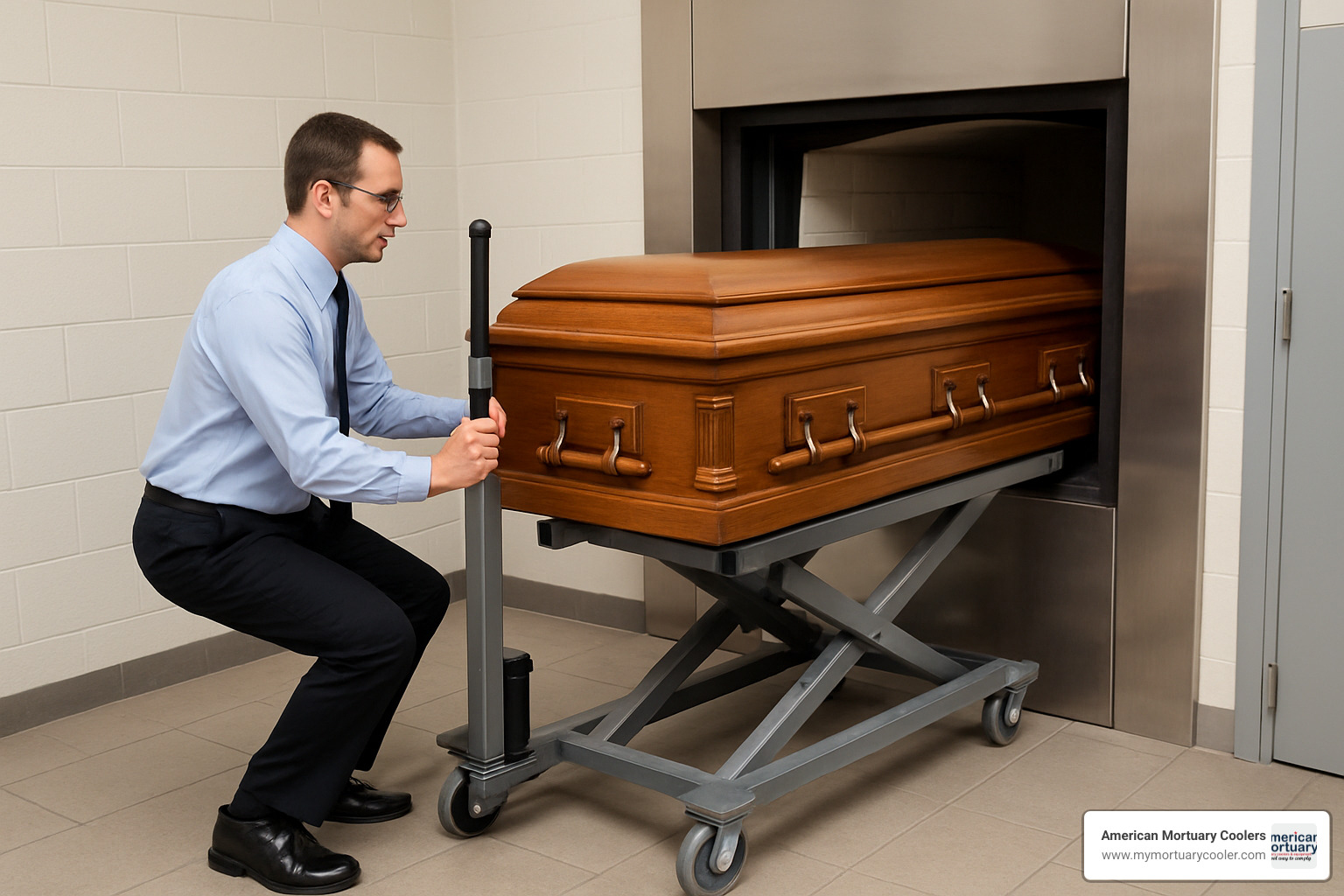
Operational Efficiency Improvements
Remember when transferring remains required a small team? With a properly selected crematory lift, a single staff member can now safely manage transfers that previously needed 2-3 people. This isn't just convenient - it's transformative for scheduling and workflow.
The multi-directional rolling system on quality lifts allows for incredible flexibility. Need to transfer from a prep table? Just roll alongside and use the side-loading feature. Moving from a vehicle? The end-loading capability has you covered. When positioned perfectly, simply engage the roller locks to secure everything in place.
A crematory manager from our Midwest service region put it perfectly: "The crematory lift paid for itself within the first year just in labor savings. But honestly, the boost in staff morale has been priceless."
Case Study: Real-World Results
When a mid-sized crematory implemented one of our battery-powered crematory lifts with multi-directional rollers, the results were remarkable:
- Single-person transfers became the norm
- Transfer times dropped from 8-10 minutes to just 3-4 minutes
- Daily capacity increased by 30% without hiring additional staff
- Staff reported feeling less physical strain and greater job satisfaction
These aren't just numbers - they represent real improvements in working conditions and business operations that make a meaningful difference every day.
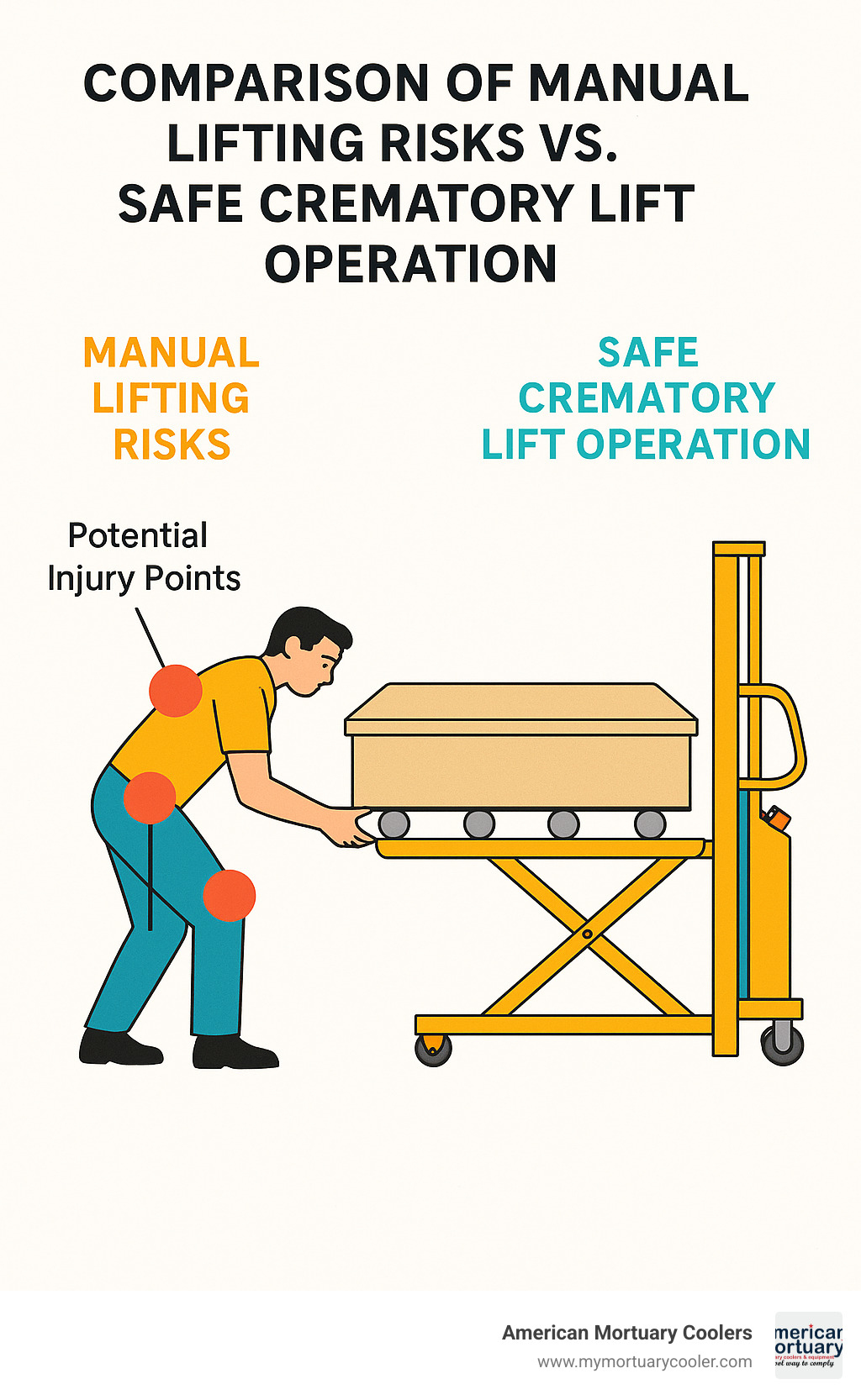
Dignified Handling of the Deceased
While we've focused on practical benefits, let's not forget what's at the heart of funeral service - providing dignified care. A quality crematory lift contributes meaningfully to this mission by ensuring smooth, controlled movement without jarring or accidents that could disturb the deceased.
For families who may witness the transfer process, seeing professional equipment being used properly communicates respect and care. It's a visible demonstration of your commitment to treating their loved one with dignity.
As one funeral director thoughtfully shared, "Families notice everything. When they see us using proper equipment instead of struggling to lift manually, it reinforces that we're professionals who take every aspect of care seriously."
Want to learn more about how these lifts can reduce workers' compensation claims? We've compiled research and case studies in our article on lifting the burden: how mortuary scissor lifts are reducing workers' comp claims.
Buying, Ownership, and Future-Proofing Your Crematory Lift
So you're thinking about investing in a crematory lift for your funeral home? This is one of those decisions that pays dividends for years to come, both for your staff's wellbeing and your bottom line. Having helped countless funeral professionals across the country find their perfect lift solution, I'd like to walk you through what to expect when making this important purchase.
Budget Considerations and Financing
Let's talk dollars and cents first. Crematory lifts typically range from $5,000 to $11,000 – a significant investment, but one that quickly proves its value. The price varies based on what you need:
Manual hydraulic models start around $5,500-$6,600, while battery-powered options run $6,800-$8,500. Aluminum construction (lighter but pricier) costs more than steel, and additional features like digital scales will bump up the price tag too.
The good news? You don't have to pay for everything upfront. Here at American Mortuary Coolers, we understand cash flow matters, which is why we offer financing with 0% down options, terms ranging from 12-60 months, and even leasing packages that include maintenance.
As one funeral director from New York told me: "The financing made all the difference. Instead of settling for the basic model, we got exactly what we needed. The monthly payment was a no-brainer compared to what we saved in labor costs."
Purchasing Restrictions and Regulations
It's worth noting that crematory lifts aren't available to just anyone. These are professional-grade tools designed specifically for our industry. To purchase one, you'll typically need to provide:
- Proof of your funeral home or crematory license
- Business verification documents
- A professional use attestation
- Compliance with any local regulations
These requirements ensure the equipment is used properly and safely by qualified professionals.
Lead Times and Planning
Planning ahead makes all the difference when purchasing a crematory lift. Here's what to expect timeline-wise:
Stock models usually ship within 2-3 weeks, while custom configurations take about 5-6 weeks to produce. Installation is quick (1-2 days), and we'll spend half a day training your team to use it properly.
I generally recommend starting the process at least two months before you need the equipment. This gives plenty of buffer for any unexpected delays and ensures a smooth transition for your team.
Accessories and Integration
Think of your crematory lift as the foundation – there are several accessories that can improve its functionality:
LCD digital weight scales ($1,500-$2,000 extra) have become increasingly popular, allowing you to verify weights immediately before cremation. Remote control operations ($500-$800) add convenience, while custom platform dimensions can accommodate specialized containers.
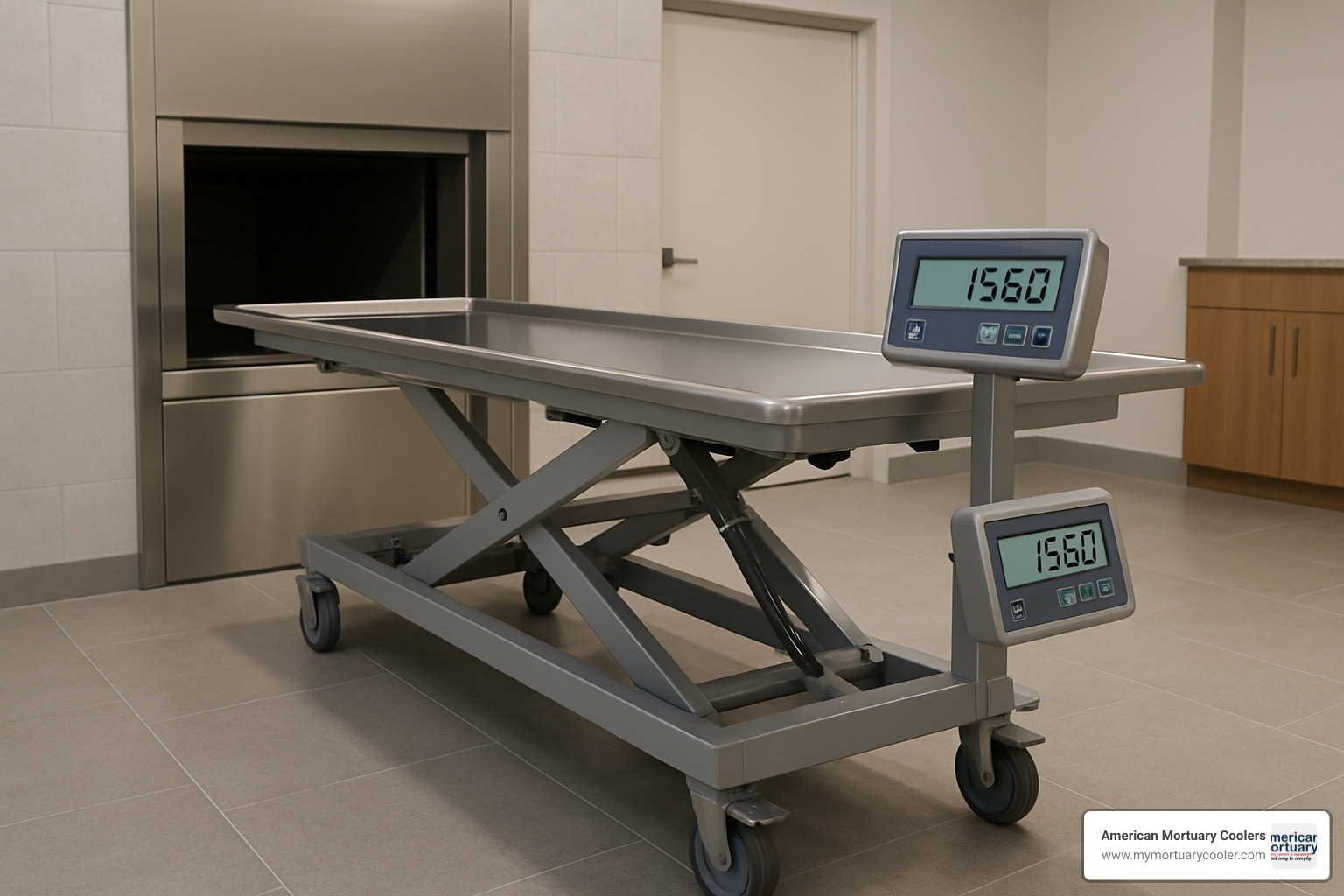
Just as important is how your new lift will work with your existing equipment. We'll help you ensure it matches the heights of your cooler compartments, aligns with vehicle loading heights, coordinates with storage racks, and fits your cremation equipment.
A crematory manager in Columbia, SC shared with me: "Adding the digital scale was the best decision we made. It's not just about confirming weights – it's about having confidence in our process and maintaining perfect records."
Maintenance Requirements and Longevity
With proper care, your crematory lift should serve you reliably for 10-15 years. The maintenance isn't complicated, but it is important.
Monthly, you'll want to visually inspect hydraulic components, check that rollers and locks function properly, assess battery charge levels (for powered models), and clean exposed surfaces.
Annually, schedule a more thorough service: a complete hydraulic system inspection, lubrication of moving parts, battery load testing, structural integrity verification, and safety feature testing.
For battery-powered models, plan to replace batteries every 3-5 years, depending on how frequently you use the lift.
Latest Trends and Future-Proofing
The crematory lift market continues to evolve with some exciting innovations. We're seeing IoT monitoring capabilities that alert you before problems arise, ultra-low profile designs starting at just 12-13 inches, and lightweight composite materials that make maneuvering even easier.
Safety features continue to improve too, with automatic braking systems becoming more common. Some models even integrate with facility management software for seamless operation tracking.
When selecting your lift, consider how these trends might affect your long-term needs. Look for models that offer upgrade paths as technology evolves, so you're not left behind as innovations become standard.
If you're curious about the latest heavy-duty lift options, check out this example of what's currently available. And if budget is a primary concern, you might consider buying a used lift – we can help guide you through that process too.
Frequently Asked Questions about Crematory Lifts
What weight capacity should my crematory lift handle?
When funeral directors ask me about weight capacity, I always tell them to think beyond today's needs. Standard crematory lifts come with a 1000 lb capacity, which handles most situations beautifully. But choosing the right capacity isn't just about averages – it's about being prepared for every family you serve.
Consider your specific situation: What's the heaviest case you've handled in the past few years? Are you noticing changing demographics in your community? Remember to account for everything going into the cremation chamber – the remains, container, and any personal items families request to include.
One of our clients in Dallas shared something that stuck with me: "We splurged on the higher capacity model even though we rarely push its limits. But that one time a year when we handle an extremely large case, having that extra capacity is absolutely priceless." That extra 15-20% in cost can provide immeasurable peace of mind when you need it most.
How often does a crematory lift need maintenance?
Like any workhorse in your funeral home, your crematory lift needs regular attention to stay reliable. Think of maintenance not as a chore, but as protecting your investment and your staff.
Your maintenance rhythm should include quick daily visual checks – just a moment to spot any hydraulic fluid leaks, make sure controls operate smoothly, verify roller locks engage properly, and check battery levels on powered models. These quick glances can prevent bigger problems down the road.
Monthly, take a bit more time to clean surfaces (using appropriate disinfectants), inspect all cables and connections, test safety features, and lubricate moving parts according to your manufacturer's guidelines. This regular TLC extends equipment life dramatically.
Once a year, schedule professional service for a thorough inspection of the hydraulic system, electrical components, structural integrity, and calibration of any weight scales. For battery-powered models, this is also the perfect time for battery load testing.
With this simple maintenance routine, your crematory lift should serve your funeral home faithfully for 10-15 years before needing major component replacement. It's a small investment of time that pays big dividends in reliability.
Are there restrictions on who can purchase a crematory lift?
Yes, and for good reason. Crematory lifts aren't general consumer products – they're professional equipment designed for trained operators in specific settings. At American Mortuary Coolers, we take these restrictions seriously to ensure safety and proper use.
We sell exclusively to licensed funeral homes, registered crematories, certain medical facilities, and educational institutions with mortuary science programs. Our verification process is thorough but straightforward – we'll need to see your business license, professional credentials, and a signed end-user agreement. We also only ship to verified business addresses, never residential locations.
A crematory owner from the Southwest recently told me, "The verification process was simple but thorough. We provided our crematory license number and business information, and approval came within 24 hours." We've streamlined the process while maintaining the necessary safeguards.
These restrictions protect everyone – ensuring this specialized equipment is used by professionals who understand proper operation and safety protocols. They also help maintain the dignity and respect that's at the heart of funeral service.
Conclusion
Selecting the right crematory lift isn't just a purchase decision—it's an investment in your staff's wellbeing, your facility's efficiency, and the dignity you provide to families. Throughout our journey serving funeral homes from our Tennessee headquarters to funeral homes across the nation, we've witnessed how the proper equipment can truly transform daily operations.
When making your selection, take time to consider what matters most for your unique situation:
- How many cases do you handle monthly, and what's your typical weight range?
- What's the physical layout of your facility, and where are the tight spots?
- Do your staff members have any existing physical limitations to consider?
- What's your realistic budget, and have you explored financing options?
At American Mortuary Coolers, we don't believe in one-size-fits-all solutions. Every funeral home has its own character, challenges, and needs. That's why we take pride in crafting custom solutions that perfectly align with your specific requirements—whether you're operating a small family-owned funeral home or a high-volume crematory.
One funeral director in Memphis told us, "I was surprised when they asked about the height of our prep room ceiling—turns out it mattered for the lift model we needed. That attention to detail made all the difference."
Your crematory lift does far more than mechanical work—it shows your commitment to staff safety, operational excellence, and respectful care. As cremation continues its steady rise across America, having the right equipment becomes not just helpful but essential to your business success.
We're here to help you steer this important decision. From our home base in Tennessee, American Mortuary Coolers delivers directly to funeral homes across the contiguous 48 states, ensuring your equipment arrives promptly and in perfect condition. And we don't disappear after delivery—we're here to support you with guidance on maintenance, accessories, and future upgrades as your needs evolve.
For personalized assistance finding your ideal crematory lift, reach out to our team. We bring decades of combined experience in mortuary equipment, a genuine understanding of funeral operations, and a commitment to finding solutions that work for your specific circumstances.



















